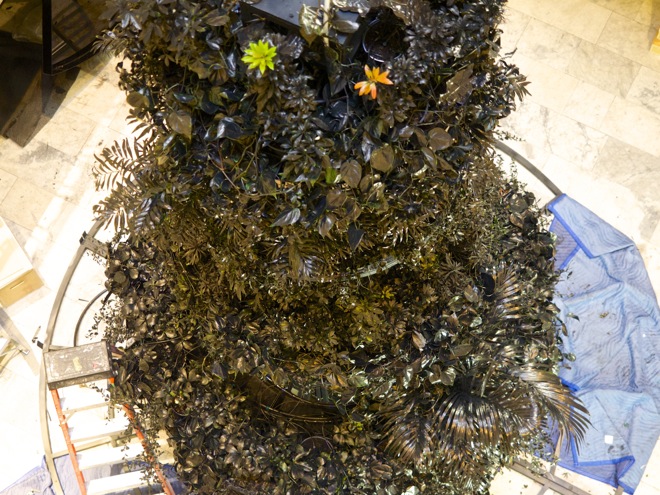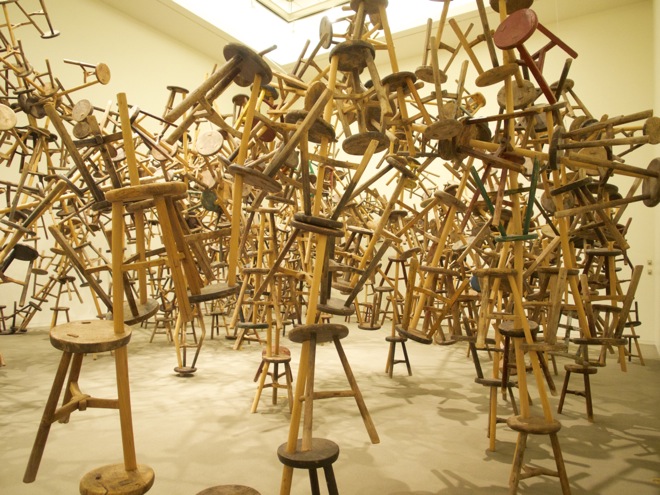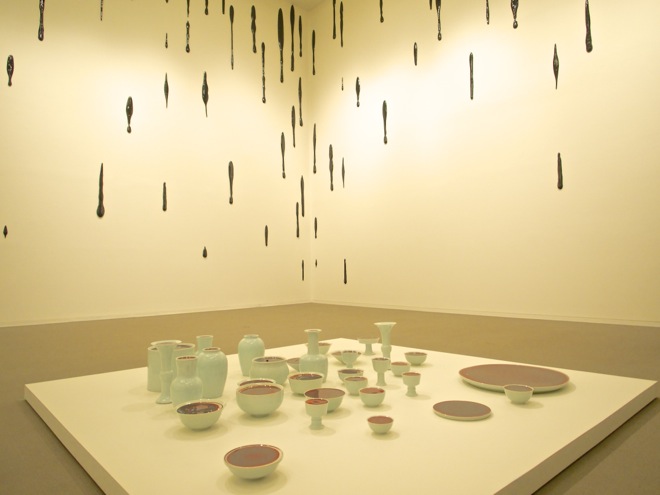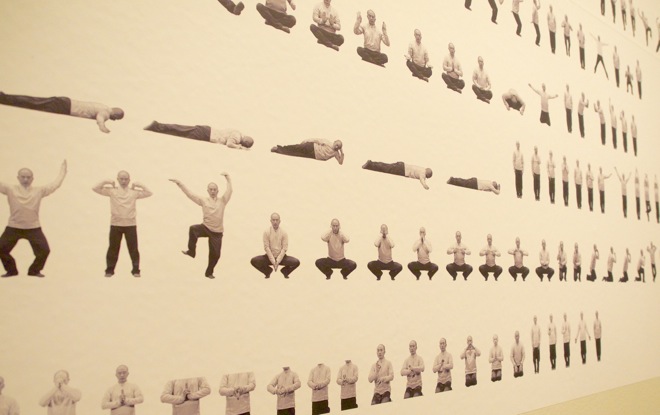by Julie Chun
UNSCROLLED: Reframing Tradition in Chinese Contemporary Art
Group exhibition: Xu Bing, Sun Xun, Liu Jianhua, Yun-Fei Ji, Chen Shaoxiong, Jennifer Wen Ma, Xu Zhen (produced by MadeIn Company), Ai Weiwei, Zhang Enli, Qiu Shihua
Vancouver Art Gallery (750 Hornby Street, Vancouver, British Columbia, Canada V6Z 2H7), Nov 15, 2014–Apr 6, 2015
The Vancouver Art Gallery has recently mounted not one but two large-scale exhibitions in order to inaugurate the newly established Institute of Asian Art. This also highlights how Vancouver, the city with the highest proportion of Asians outside Asia, embraces cultural diversity. The Institute of Asian Art, launched in the fall of 2014, promises to be a comprehensive initiative to advance the scholarship and public appreciation of the arts from China, India, Japan and Korea. With the opening of “The Forbidden City: Inside the Court of Chinese Emperors” (Oct 18, 2014–Jan 11, 2015), the first floor galleries featured nearly 200 meticulously assembled iconic objects from the collections of the Palace Museum in Beijing. In its wake, almost a month later, “Unscrolled: Reframing Tradition in Chinese Contemporary Art” was unveiled on the second level of the museum on November 14 to a wide audience of museum patrons, financial sponsors, and members of the local community.
While organized by different curators and entities, the two complementing exhibitions featuring ancient and contemporary works of art attempted to forge a relevant link between China’s opulent dynastic past with its frenetically transforming present. Carefully ordered and ensconced in glass cases (curio cabinets come to mind), the artifacts on the first floor evoked the fetishization of history. Conversely, nearly thirty objects comprised mostly of paintings, video projections and installations on the second floor sought to dispel the orientalizing view of “the other” as an indication of a contemporary “another,” marking the shift that has been taking place in Chinese art in the last decade.
Notwithstanding the concern of co-curators Diana Freundl (Vancouver Art Gallery) and Carol Yinghua Lu (artistic director of OCAT Shenzhen), it seemed to matter little to the guests that on the opening night of “Unscrolled”, Jennifer Wen Ma’s installation of 750 hand-painted and dipped potted plants “Inked Chandelier” (2014) could not be hoisted up in time due to structural difficulties. They simply walked around it, admiring the unusual presence of lush shrubbery in the gallery.
In accordance with the curatorial theme of “re-framing tradition,” Ma’s Inked Chandelier” exemplifies the highly personal and often evolving decision to maintain or cast off one’s tradition. Each pot of native Canadian plant was fully covered with traditional Chinese ink (a composite material of charcoal, water, and binding agent), a texture that governs much of Ma’s artistic practice. The artist noted that the site-specific live sculpture is intended to provide a visual dialogue between the past and present by emphasizing time as an element of the composition. She is interested in the transformative process occurring in tradition that will be mirrored in her work. According to Ma, some plants will inevitably succumb to the duress of pollutants and the disruption of natural photosynthesis, but she also firmly believes some stalks will manage to sprout new leaves and blossom flowers, symbolizing the uneven process of regeneration and degeneration. For Jennifer Wen Ma, inked expressions served as an important mode of communication in China for thousands of years. She hopes her “inked landscape will provide a commentary on the way we live today [revealing] the individual decisions that are made under the stress of everyday life.”


As the viewers followed the vertical trajectory of “Inked Chandelier” up the spiral staircase to the second floor, all eyes alighted on Xu Bing’s “Background Story: Ten Thousand Li of Mountains and Rivers” (2014). Constituted as a reiteration of the Southern Song dynasty artist Zhao Fu’s (active c. 1131-62) landscape ink painting, Xu Bing’s ten-meter long landscape is composed not as a marked surface but with remnants of natural and recycled debris filtered through a large frosted panel brightly lit from behind. Although constructed on site, like many of the works in the “Unscrolled” exhibition, Xu Bing’s fabricated landscape takes its form from earlier iterations. Begun in 2004 while he was preparing for his solo exhibition in Berlin, Xu came upon photographs of Chinese ink paintings that were subsequently looted from the Museum für Ostasiatische Kunst.(1) In order to reveal the presence of absence, the artist decided to recreate and thereby expose the disarray of behind-the-scenes disquietude that directly contradicts the seemingly tranquil front-piece image.
It appears that many Vancouverites are unfamiliar with the vast territory of Chinese contemporary art. Out of the several viewers queried, only one person knew of another artist (Xu Bing) in the group aside from Ai Weiwei. Olivier Guay-Cyr, a musician in his early twenties, commented that he had no idea of the diversity in Chinese contemporary art prior to viewing “Unscrolled”. He was especially drawn to the paintings by Zhang Enli. “I can definitely sense the evolving progress through the images on these large-scale canvases. The artist is using the empty space but in a modern context to bring forth a new emotion. Perhaps in an over-crowded place like China, the artist feels the need to seek out empty spaces,” Guay-Cyr observed. Indeed, Zhang Enli’s large canvases with deft strokes of circumscribed forms evince the quiet spiritual mindset of the artist. In his seemingly uninhabited renderings, Zhang advances the ideals of the limitless through the limitation of the structural support of the canvas.
“There are lots of references in each of the works in the exhibition. Some of them are accessible, but some were not, so it was very helpful to receive personal insights from the artists,” remarked Edward L. Nygren, a local artist and photographer, after the artist-led guided talk by Zhang Enli, Liu Jianhua and Jennifer Wen Ma. In an uncanny way, Ai Weiwei, who remains confined in Beijing, also inhabited a looming presence with the monumental floor-to-ceiling installation “Bang!”—a rhizomatic matrix of 886 antique wooden stools that seemed to float and drift of their own accord, despite being joined to one another. Moreover, Ai Weiwei was thoughtfully presented in Vancouver for the general audience to better understand this controversial artist. Along with the well-attended screening of Alison Klayman’s documentary Ai Weiwei: Never Sorry at the Vancouver Cinmatheque on the evening of November 12, the Morris and Helen Belkin Art Gallery at the University of British Columbia displayed “Ai Weiwei: New York Photographs 1983-1993”, a traveling exhibition of 227 black and white photographs taken by the artist as a young immigrant. These visual glimpses provided a revealing and even poignant personal narrative of an artist well known to the world for his staunch political activism against the Chinese state.


Another highlight of the exhibition for many viewers was the large gallery dedicated to Liu Jianhua’s large drips of black glazed porcelains mounted on the wall entitled “Traces” (2011) and his equally iconic re-imagined Song dynasty porcelain vessels filled with pools of red glazes called “Container” (2009). The lofty high ceiling combined with the juxtaposed placement of the ritual vessels on the floor, with their reference to blood, caused viewers to pause in hushed solemnity, as if entering a sacred site.
The various messages conveyed by Yun-Fei Ji, Chen Shaoxiong and Xu Zhen of MadeIn Company were presented in visual forms that have their roots in Chinese culture, yet parlayed with each artist’s individual commentary about the social conditions of the present day. With Yun-Fei Ji, the referent is overt and clear. Re-appropriating the venerated format of ink scrolls and paintings, Ji underscores the injustices faced by scores of displaced Chinese at the hands of the authorities. The images on his colored ink and woodblock renderings are sharp and succinct, devoid of superfluous lyricism, to provide a discernable manifestation of the Chinese expression “eating bitterness,” which alludes to the agony of enduring suffering. Chen Shaoxiong’s accumulation of monochrome drawings, “Ink Things” (2007), represents mundane-looking objects from Chinese urban life such as socks, a battery, a radiator, an emergency exit sign and a roll of toilet paper, to name but a few. Two sets of video projections replaying all of his 70 ink drawings are inserted among the actual paintings. It is easy for viewers to glide through this seemingly simple installation, mostly because the small-scale paintings mimic the compulsory still-life studies in watercolor required for all art students. It was remiss that Chen’s immense repertoire “Ink Media” (2011-12) and “Ink History” (2008-10) were not on view in Vancouver, because this would have demonstrated that there are scores of Chinese artists other than Ai Weiwei (such as Yun-Fei Ji mentioned above) who are concerned with depicting the issue of social justice or the lack thereof (Chen Shaoxiong’s more potent series is currently installed at the Seattle Art Museum for his solo exhibition). The theme and subject matter of Chen’s 150 plus ink paintings executed in the same small-scale monochrome format vividly highlight public protests which have taken place around the world, including those in China.



Xu Zhen of MadeIn Company is notorious for using humor in his artistic practice. Having incorporated himself as the company MadeIn in 2009, he has recently announced that the company will start representing the artist Xu Zhen; the company also recently opened its very own gallery in Shanghai. Xu Zhen’s “Physique of Consciousness” (2012) and its accompanying “Physique of Consciousness Museum” (2013) irreverently subvert the process of socialization and rituals from the East, West, or elsewhere. Xu Zhen’s “Physique of Consciousness” draws attention to what may seem familiar such as his use of taichi, a daily exercise embraced as a ritual for generations of Chinese.
Qiu Shihua’s gallery of white canvases rounded out the show. Bathed in their near-monochrome opaqueness, Qiu’s series of Untitled works on canvas and paper signifies the conflating Daoist principles of the negative with the positive. As if playing a game of I SPY, many viewers stood at oblique angles, searching earnestly for the trees and landscape that was, as stated on the wall text, inscribed in the paintings. Everyone in the room was constantly moving about when the imperative was to remain still. The artist Huang Yong Ping once commented that the moment of one’s realization of emptiness is the moment when the mind is opened to receive the truth. It is the all-encompassing embrace of the metaphysics that also guides the hands of the artist like Qiu Shihua. In the video where he discusses his paintings, Qiu remarks, “There is no beginning and there is no end. The end is just another beginning.” The final gallery of the “Unscrolled” exhibition thus represented a cyclical portal, the end of a beginning.
It goes without saying that tradition (and the customs and rituals that constitute it) is deeply tied to the circumstances of time and space. Tradition as a symbolic marker of national, regional and personal identity has historically been adopted to fashion hierarchies of social order. As the historian Eric Hobsbawm has posited, tradition is “invented” (2) and is often fraught with contestations and even caesurae. While hardly comprehensive (the inclusion of only one female artist is stark when the intent is to subvert age-old conventions), “Unscrolled” nonetheless manages to reveal the minute and monumental tensions arising out of cities in China where transformative shifts require negotiations on both collective and individual levels—and fostering a conversation with the local audience in Vancouver curious about China.
(1) Robert E. Harrist Jr., “Background Story: Xu Bing’s Art of Transformation,” in Reiko Tomii et al., Xu Bing (London: Albion, 2011), 33–43.
(2) Eric Hobsbawm, “Introductions: Inventing Traditions,” in The Invention of Tradition, edited by Eric Hobsbawm and Terence Ranger (Cambridge: Cambridge University Press, 2004 reprint), 1-14.


